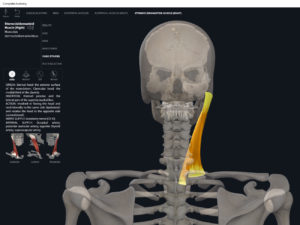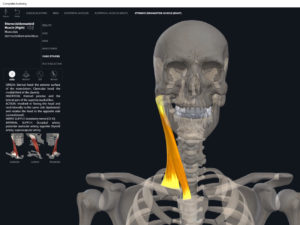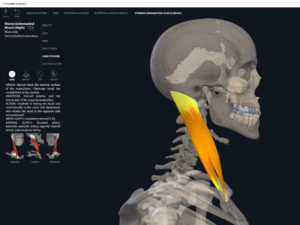Anatomy & Physiology: Muscles—Sternocleidomastoid.
Structure.
- Origin: sternal head—top of manubrium; clavicular head—medial 1/3 of clavicle.
- Insertion: mastoid process, lateral superior nuchal line of occipital.
Function.
- Concentric action: cervical flexion, rotation, and lateral flexion.
- Reverse mover action: elevate sternum and clavicle; ipsilateral rotation of trunk.
- Eccentric action: controls/restrains/slows cervical extension, rotation, and lateral flexion.
- Isometric action: stabilization of the cervical spine and acromioclavicular joint.
- Innervation: cranial nerve XI (accessory).
- Arterial supply: occipital and posterior auricular arteries, superior thyroid artery.
Clinical Significance.
More.
- http://anatomyzone.com/tutorials/musculoskeletal/organisation-of-the-neck/
- https://www.anatomynext.com/sternocleidomastoid/
References
Biel, A. (2015). Trail guide to the body: A hands-on guide to locating muscles, bones and more.
Cedars-Sinai. (2018). Vertebrae of the spine. Retrieved from https://www.cedars-sinai.org/health-library/diseases-and-conditions/v/vertebrae-of-the-spine.html
Clark, M., Lucett, S., Sutton, B. G., & National Academy of Sports Medicine. (2014). NASM essentials of corrective exercise training. Burlington, MA: Jones & Bartlett Learning.
Jenkins, G., & Tortora, G. J. (2012). Anatomy and Physiology: From Science to Life, 3rd Edition International Stu. John Wiley & Sons.
Muscolino, J. E. (2017). The muscular system manual: The skeletal muscles of the human body.



